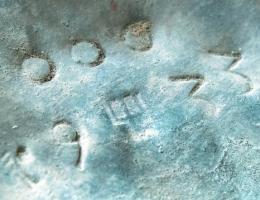
Copper plate bearing Fugger family marks
In early January, we posted about the containership ship MSC Zoe which lost 350 containers over the side in a storm off the Frisian Islands of the Netherlands. Now, a Dutch salvage team, looking for lost containers from the Zoe, has discovered a shipwreck believed to date from around 1540 on the North Sea bottom.
The shipwreck is said to be the oldest sea-going ship ever found in Dutch waters. The ship was loaded with copper plates bearing the symbol of the Fugger family, a merchant banking family based in Augsburg in Germany, which for a time also held a monopoly over copper production. The ship estimated to be 30m by 7m could have been carrying as much as 5,000 kg (five tonnes) of copper.
The ship is also historically interesting as its structure represents a transition from the old clinker or lapstrake-type, and the more advance carvel construction of smoothly fitting planks over a frame structure, which had developed in the Mediterranean. Reports are that the ship had elements of each form in its construction.
The BBC reports that a copper expert from the Rijksmuseum in Amsterdam has identified the chemical substance in the cargo as identical to the first copper coins used in the Netherlands.
Copper coins were at the time being developed as a lower-cost alternative to gold and silver, and it now appears that copper from the mines in Slovakia was being used as currency in the Netherlands. The Fugger family had a very large copper mine in Slovakia.
Thanks to Irwin Bryan for contributing to this post.

More; PLUS the Burgzand
Noord 17
https://nltimes.nl/2019/04/03/16th-century-dutch-shipwreck-found-shipping-accident-cleanup
https://www.archaeology.org/news/7520-190403-netherlands-copper-shipwreck
https://www.archaeology.org/issues/296-1805/features/6507-netherlands-texel-shipwreck